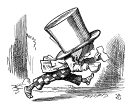Search us!
Search The Word Detective and our family of websites:
This is the easiest way to find a column on a particular word or phrase.
To search for a specific phrase, put it between quotation marks. (note: JavaScript must be turned on in your browser to view results.)
Ask a Question! Puzzled by Posh?
Confounded by Cattycorner?
Baffled by Balderdash?
Flummoxed by Flabbergast?
Perplexed by Pandemonium?
Nonplussed by... Nonplussed?
Annoyed by Alliteration?

Don't be shy!
Send in your question!
Columns from 1995 to 2006 are slowly being added to the above archives. For the moment, they can best be found by using the Search box at the top of this column.
 If you would like to be notified when each monthly update is posted here, sign up for our free email notification list.
If you would like to be notified when each monthly update is posted here, sign up for our free email notification list.
Trivia
All contents herein (except the illustrations, which are in the public domain) are Copyright © 1995-2020 Evan Morris & Kathy Wollard. Reproduction without written permission is prohibited, with the exception that teachers in public schools may duplicate and distribute the material here for classroom use.
Any typos found are yours to keep.
And remember, kids,
Semper Ubi Sub Ubi
|
From drink to think.
Dear Word Detective: My kids think the word “noggin” is hilarious. I have used it, in reference to their heads, and wondered about its history. Where, when and how did this word come into being? — Juliet.
Well, it was a dark and stormy night in the 1930s as Elwood Noggin, a retired stoat salesman in northern Nebraska, tinkered in his basement with his latest invention, an electric divining rod for locating lost car keys. As Noggin reached for the switch to test his invention, suddenly…. One moment please. I have just been informed that the foregoing story is not true. Oh well, that sort of fable almost never is. One might (as I sometimes do) view human history itself as being one long dark and stormy night, but few of our words have identifiable “moments of origin.” Like Topsy, they just sort of grow.
 But the results in cases such as “noggin” are nonetheless splendid. As slang for the human head (or any creature’s head, I suppose, although references to a cat’s noggin in classic literature seem rare), “noggin” is a wonderfully silly word. It’s difficult to imagine using “noggin” when genuine anger is involved, and “noggin” seems far more likely to crop up in an S.J. Perelman story or a Three Stooges episode than in a crime report. But the results in cases such as “noggin” are nonetheless splendid. As slang for the human head (or any creature’s head, I suppose, although references to a cat’s noggin in classic literature seem rare), “noggin” is a wonderfully silly word. It’s difficult to imagine using “noggin” when genuine anger is involved, and “noggin” seems far more likely to crop up in an S.J. Perelman story or a Three Stooges episode than in a crime report.
Oddly enough, when “noggin” first appeared in English in the late 16th century, it had nothing to do, at least directly, with the human head. It mean “small cup or mug,” and by a hundred years later, had taken on the meaning of “a small drink of alcohol.” The roots of “noggin” are a mystery, but that second meaning of “small drink” may provide a clue. “Nog” at that time was a term used in England for a type of strong ale (or, by extension, any sort of alcoholic drink). It’s that “nog,” in fact, that underlies our modern “eggnog,” which combines (in its proper form) eggs, cream, sugar, nutmeg and rum. It’s possible that, since liquor affects primarily the head, that “noggin” was originally meant to refer to a head made woozy by drink. In any case, by the mid-18th century “noggin” had come into use as slang for the head, at first as a boxing term, but by the 19th century as a generalized slang term.
It is also possible that the transferred use of “noggin” from “cup” to “head” paralleled the evolution of “mug” in slang. In the 16th century, a “mug” was, as it is today, a heavy cup used for warm drinks. But in the 17th century it became common to decorate mugs with grotesque caricatures of human faces (such creations are still found in many curio and souvenir shops). By the early 18th century, “mug” had become popular slang for the actual human face, a sense we still use in “mugshot” (as well as in “to mug,” which originally referred to hitting a person in the face).
Like a scrapbook full of beets.
Dear Word Detective: I recently bought one of those home vacuum-sealing gizmos, which has proven quite useful since I’m on a special diabetic diet and often work long hours. Now I can do lots of cooking on one weekend a month and bag up and freeze or refrigerate a bunch of portion-controlled meals. Result: All the convenience of store-bought microwave dinners without the boatloads of sodium, sugar, fat and other things I’m supposed to keep away from. For my birthday I got a jar-sealing attachment, and that leads me to my question. The jar thingy is designed to work with “mason” or “canning” jars. So, why are the jars used for preserving fruits and veggies and the like called “mason” jars and why is the process of sealing such stuff in glass jars called “canning”? — Joseph DeMartino.
Well, there you go. At least some people appreciate useful gizmos as gifts. A certain person I seem to have married received a very nice paper shredder for Christmas a few years ago. Her reaction, contrary to my expectations, did not peg the enthusiasm meter. But now, without fail, she mentions said gift within twenty minutes of meeting anyone.
What makes this especially odd is that she has yet to open the box.
 The use of “can” to mean “seal food in a glass jar” does seem illogical, until we note that the process of preserving food in cans uses roughly the same method you use in “putting up” food in jars, namely heating the food in the vessel to eliminate bacteria and then sealing the container with a vacuum. This method of preserving food was invented in the late 18th century by Nicolas Appert in France in response to a call by Napoleon Bonaparte for a system of supplying French troops with preserved food that could both be easily transported overseas and actually eaten. (Existing methods relied on drying, smoking, and/or salting the food.) Appert’s invention used fragile glass bottles, however, and it was only with the substitution of durable tin cans by Peter Durand of England that the process really took off and led to a worldwide revolution in preserving food. The word “can,” by the way, comes from the Latin “canna” (meaning “container”), and is unrelated to “can” meaning “to be able,” which comes from a Germanic root meaning “to know.” The use of “can” to mean “seal food in a glass jar” does seem illogical, until we note that the process of preserving food in cans uses roughly the same method you use in “putting up” food in jars, namely heating the food in the vessel to eliminate bacteria and then sealing the container with a vacuum. This method of preserving food was invented in the late 18th century by Nicolas Appert in France in response to a call by Napoleon Bonaparte for a system of supplying French troops with preserved food that could both be easily transported overseas and actually eaten. (Existing methods relied on drying, smoking, and/or salting the food.) Appert’s invention used fragile glass bottles, however, and it was only with the substitution of durable tin cans by Peter Durand of England that the process really took off and led to a worldwide revolution in preserving food. The word “can,” by the way, comes from the Latin “canna” (meaning “container”), and is unrelated to “can” meaning “to be able,” which comes from a Germanic root meaning “to know.”
Sealing food in metal cans, however, has never really proven practical in the home kitchen (sealing the cans pretty much requires soldering, for instance), so the use of glass containers has been far more successful. With the success of commercial canning, it was natural to use “can” as the verb for “putting up” food in jars (perhaps especially since “jar” as a verb in this context raises the specter of broken glass on the floor). The Mason jar, a heavy glass jar with a threaded lid sealed by a rubber grommet, was invented by tinsmith John Mason in 1858, and the simplicity and durability of his design has made the Mason jar the de facto standard of home canning ever since.
The human touch.
Dear Word Detective: What does “grifter” mean? I hear it often but it’s not in any dictionary. — Debbie W.
 Um, exactly how often do you hear “grifter”? I ask only because I almost never hear it, and while that may be because I swore off television last year, I’m worried that hearing the word “grifter” too often bespeaks an unhealthy environment, unless one works for the FBI. On the other hand, if you worked for the FBI, you’d know what “grifter” means. Um, exactly how often do you hear “grifter”? I ask only because I almost never hear it, and while that may be because I swore off television last year, I’m worried that hearing the word “grifter” too often bespeaks an unhealthy environment, unless one works for the FBI. On the other hand, if you worked for the FBI, you’d know what “grifter” means.
A “grifter,” simply put, is a con artist, a swindler, a petty criminal who runs scams, schemes and flim-flams on unsuspecting “marks” (con artist lingo for victims). Often a grifter exploits human weaknesses and vulnerabilities, especially greed and loneliness, to extract money from the mark, and does it with a routine so convincing that the police frequently have a hard time convincing the mark that he or she has been the victim of a crime. The categories of “con artist,” “swindler” and “grifter” are not precise and overlap, but generally a “grifter” tries to forge a personal relationship with the victim and then extracts loans and other expensive favors. A case a few years ago in New York City made headlines when a “mother and son grifter team” lost control of their scheme and murdered their victim, an elderly society heiress.
“Grifter” is an American invention, dating back to the early 20th century, but appears to be based on the slightly older slang term “grafter,” also meaning “swindler,” “con man” or simply “thief.” Some authorities believe that “grifter” is actually a combination of “grafter” and “drifter,” reflecting the rootless, peripatetic nature of many grifters’ lives.
“Grafter,” in turn, comes from the noun “graft,” meaning, as the Oxford English Dictionary defines it, “the obtaining of profit or advantage by dishonest or shady means; the means by which such gains are made, especially bribery, blackmail, or the abuse of a position of power or influence.” If “graft” sounds familiar, it’s probably because you’ve seen it in the all-too-common phrase “graft and corruption” applied to crooked politicians. The roots of “graft” in this sense are uncertain, but it may be based on an old British slang use of “graft” to mean “dig” or “work,” based on the same root that gave us “grave.”
|
Makes a great gift! Click cover for more.  
400+ pages of science questions answered and explained for kids -- and adults!
FROM ALTOIDS TO ZIMA, by Evan Morris
 
|
 But the results in cases such as “noggin” are nonetheless splendid. As slang for the human head (or any creature’s head, I suppose, although references to a cat’s noggin in classic literature seem rare), “noggin” is a wonderfully silly word. It’s difficult to imagine using “noggin” when genuine anger is involved, and “noggin” seems far more likely to crop up in an S.J. Perelman story or a Three Stooges episode than in a crime report.
But the results in cases such as “noggin” are nonetheless splendid. As slang for the human head (or any creature’s head, I suppose, although references to a cat’s noggin in classic literature seem rare), “noggin” is a wonderfully silly word. It’s difficult to imagine using “noggin” when genuine anger is involved, and “noggin” seems far more likely to crop up in an S.J. Perelman story or a Three Stooges episode than in a crime report.

 can be found
can be found 
 The use of “can” to mean “seal food in a glass jar” does seem illogical, until we note that the process of preserving food in cans uses roughly the same method you use in “putting up” food in jars, namely heating the food in the vessel to eliminate bacteria and then sealing the container with a vacuum. This method of preserving food was invented in the late 18th century by Nicolas Appert in France in response to a call by Napoleon Bonaparte for a system of supplying French troops with preserved food that could both be easily transported overseas and actually eaten. (Existing methods relied on drying, smoking, and/or salting the food.) Appert’s invention used fragile glass bottles, however, and it was only with the substitution of durable tin cans by Peter Durand of England that the process really took off and led to a worldwide revolution in preserving food. The word “can,” by the way, comes from the Latin “canna” (meaning “container”), and is unrelated to “can” meaning “to be able,” which comes from a Germanic root meaning “to know.”
The use of “can” to mean “seal food in a glass jar” does seem illogical, until we note that the process of preserving food in cans uses roughly the same method you use in “putting up” food in jars, namely heating the food in the vessel to eliminate bacteria and then sealing the container with a vacuum. This method of preserving food was invented in the late 18th century by Nicolas Appert in France in response to a call by Napoleon Bonaparte for a system of supplying French troops with preserved food that could both be easily transported overseas and actually eaten. (Existing methods relied on drying, smoking, and/or salting the food.) Appert’s invention used fragile glass bottles, however, and it was only with the substitution of durable tin cans by Peter Durand of England that the process really took off and led to a worldwide revolution in preserving food. The word “can,” by the way, comes from the Latin “canna” (meaning “container”), and is unrelated to “can” meaning “to be able,” which comes from a Germanic root meaning “to know.” Um, exactly how often do you hear “grifter”? I ask only because I almost never hear it, and while that may be because I swore off television last year, I’m worried that hearing the word “grifter” too often bespeaks an unhealthy environment, unless one works for the FBI. On the other hand, if you worked for the FBI, you’d know what “grifter” means.
Um, exactly how often do you hear “grifter”? I ask only because I almost never hear it, and while that may be because I swore off television last year, I’m worried that hearing the word “grifter” too often bespeaks an unhealthy environment, unless one works for the FBI. On the other hand, if you worked for the FBI, you’d know what “grifter” means.



Recent Comments